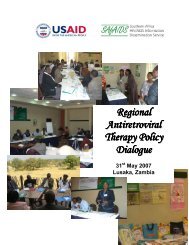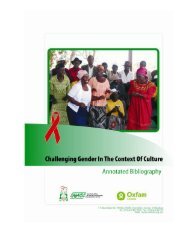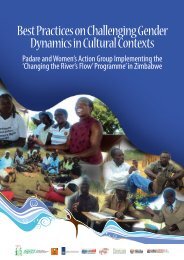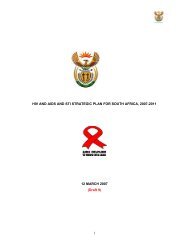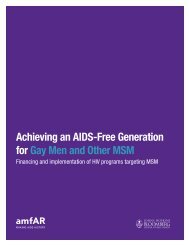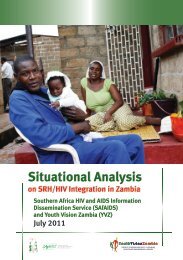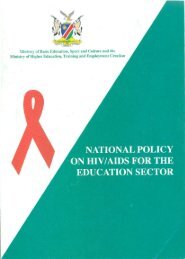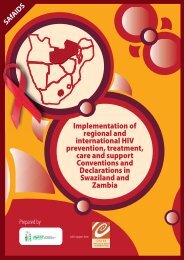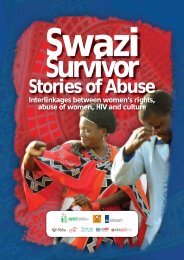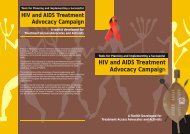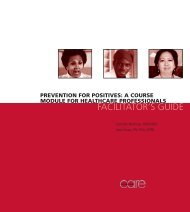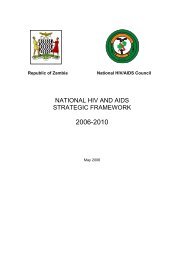2008 05 09 OVC Best Practices.pdf - SAfAIDS
2008 05 09 OVC Best Practices.pdf - SAfAIDS
2008 05 09 OVC Best Practices.pdf - SAfAIDS
You also want an ePaper? Increase the reach of your titles
YUMPU automatically turns print PDFs into web optimized ePapers that Google loves.
funding. Social inclusion is a complex issue that requires sensitive handling to<br />
support analysis, reflection and action by community members.<br />
The Framework outlines three steps involved in creating a supportive environment.<br />
An enabling environment is created by supportive policies and legislation, including<br />
commitment of funds for continued work. At the community level, it is valuable to<br />
conduct a collaborative situation analysis. To this end, the Alliance and its partners<br />
developed a series of participatory activities to stimulate community-based analysis,<br />
reflection and action to address stigma and discrimination, and promote social<br />
inclusion. These activities form part of the “Building Blocks” series for community<br />
support to orphans and vulnerable children, available from the Alliance at<br />
www.aidsalliance.org.<br />
Secondly, influential leaders must be mobilised to reduce stigma, silence and<br />
discrimination. It is significant to remember that community leaders can take a variety<br />
of different actions to reduce stigma and discrimination. Additionally, leaders can be<br />
very different in different contexts, and it is important to consider young people as<br />
part of the solution.<br />
Finally, we must strengthen and support social mobilisation activities at the<br />
community level. Community leaders and NGOs can work with community members<br />
to support the rights of families affected by HIV/AIDS. An example of this comes from<br />
Southern India, where a family of four girls who had lost their father to AIDS were<br />
unable to make a living from using his fishing-net, due to gender-based social norms.<br />
The community was able to find a solution, renting the fishing net from the family,<br />
thus giving them a small income. While this does not address the underlying gender<br />
based restrictions, it recognises that changes occur in small steps, and finds a<br />
pragmatic, short-term solution in the interim. This solution was possible because of<br />
the long-term relationship between the NGO and the community leader, and his own<br />
understanding of HIV and its impacts, including his belief in defending the families’<br />
right to an income.<br />
Strengthening Social Mobilisation Efforts at the Community Level<br />
Tearfund discussed its distinctive role in responses to children affected by HIV and<br />
AIDS through direct contact with Christian grassroots organisations, highlighting<br />
lessons learned from initiatives in Kenya, Mozambique and Zimbabwe on mobilising<br />
communities and building on existing community initiatives in responses to children<br />
affected by HIV and AIDS.<br />
As part of a community based nutrition programme in Kenya, Tearfund studied the<br />
effectiveness of social mobilisation at community level that sought to prevent the<br />
urban migration of orphan adolescent girls. The programmatic research focused on<br />
strengthening communities’ ability to use their own resources and to improve their<br />
access to a range of resources for themselves. Community action plans were<br />
successfully used for identifying problems and mobilising collective action to address<br />
impacts of the epidemic for local communities. As a result of the increased<br />
recognition of the social disruption caused by migrating orphan girl adolescents,<br />
groups now focus on maintaining support for them within the community.<br />
Lessons learned by Tearfund partner organisations in a number of different contexts<br />
also point to the importance of external support strengthening and supporting social<br />
mobilisation at the community level for sustainable responses to children and<br />
communities affected by HIV and AIDS.<br />
14



